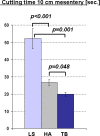Safety and efficacy of new integrated bipolar and ultrasonic scissors compared to conventional laparoscopic 5-mm sealing and cutting instruments
- PMID: 22447285
- PMCID: PMC3427482
- DOI: 10.1007/s00464-012-2229-0
Safety and efficacy of new integrated bipolar and ultrasonic scissors compared to conventional laparoscopic 5-mm sealing and cutting instruments
Abstract
Background: Hemostasis is a central issue in laparoscopic surgery. Ultrasonic scissors and bipolar clamps are commonly used, with known advantages with each technique.
Methods: The prototype of new surgical scissors, delivering ultrasonically generated frictional heat energy and bipolar heat energy simultaneously (THUNDERBEAT(®) [TB]), was compared to ultrasonic scissors (Harmonic ACE(®) [HA]) and an advanced bipolar device (LigaSure(®) [LS]) using a pig model. As safety parameters, temperature profiles after single activation and after a defined cut were determined. As efficacy parameters, seal failures and the maximum burst pressure (BP) were measured after in vivo sealing of vessels of various types and diameters (categories 2-4 and 5-7 mm). Moreover, the vertical width of the tissue seal was measured on serial histological slices of selected arteries. The cutting speed was measured during division of isolated arteries and during dissection of a defined length of compound tissue (10 cm of mesentery). Burst-pressure measurement and histological analysis were performed by investigators blinded to the used sealing device.
Results: Using the TB, the burst pressure in larger arteries was significantly higher (734 ± 64 mmHg) than that of the HA (453 ± 50 mmHg). No differences in the rate of seal failures were observed. The cutting speed of the TB was significantly higher than that of all other devices. Safety evaluation revealed temperatures below 100 °C in the bipolar device. The maximum temperature of the HA and the TB was significantly higher. No relevant differences were observed between the HA and the TB.
Conclusions: The ultrasonic and bipolar technique of the TB has the potential to surpass the dissection speed of ultrasonic devices with the sealing efficacy of bipolar clamps. However, heat production that is comparable to conventional ultrasonic scissors should be minded for clinical use.
Figures







References
-
- Kasalický M, Krsek M, Zelinka T, Hána V, Widimský J. 120 laparoscopic adrenalectomies with a harmonic scalpel. Rozhl Chir. 2009;88:439–443. - PubMed
-
- Gertsch P, Pelloni A, Guerra A, Krpo A. Initial experience with the harmonic scalpel in liver surgery. Hepatogastroenterology. 2000;47:763–766. - PubMed
Publication types
MeSH terms
LinkOut - more resources
Full Text Sources
Research Materials
Miscellaneous

